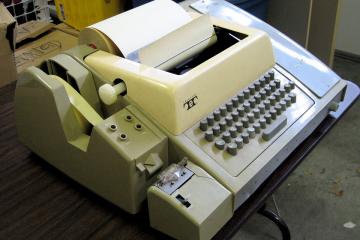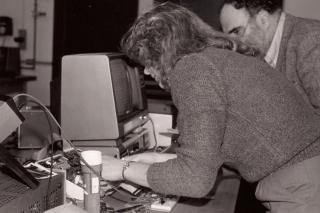In the 1970s, computer science programs in undergraduate education were rare. How, then, was a Bachelor’s in Computer Science (BS), a program in a male-dominated field, established at a small women-centered institution?
The answer begins with Professor Margaret Menzin, who began her career as a programmer at Service Bureau Corporation, a subsidiary of IBM. Menzin came to Simmons in 1969 to teach mathematics. “In the 60s and 70s, if you wanted to learn about computers, you went to work for a computer company,” she says. At IBM, Menzin recalls, the “three predictors of success for a programmer [now computer scientist] were an ability in math, foreign languages, and problem-solving.”
Menzin realized that “Raytheon and General Electric were hiring our math and physics majors and turning them into computer scientists. We asked, ‘would you hire a computer science major?’ but they said no. They knew what a math major was, not a computer science major.”
With Professor (now Emeritus) Edward Prenowitz, Menzin received approval to launch the major in 1975 — one of the very first undergraduate programs in computer science. “The university was supportive of bottom-up curricular initiatives. It would have been much harder to start an undergrad major in computer science at a larger university. At Simmons, they [university administration] supported us.”
Computing at Simmons in the 1970s
“In the early 1970s, large mainframe computers were manufactured by IBM for weather services, insurance companies, and large schools, like MIT,” says Emeritus Faculty member Leonard Soltzberg, who taught Chemistry at Simmons.
The first computer on the Simmons campus was a “minicomputer” created by Digital Equipment Corporation, which Psychology professor Teresa Carterette purchased with a research grant and trained her students to use for their research project. Aside from Carterette’s research, all other computer work emanating from Simmons was a laborious process, with the computing element completed off-site.
“The math department had a programming course using FORTRAN, which was an early high-level computer language,” says Soltzberg. For this class, students were assigned to write simple programs, such as to determine the area of a trapezoid, including labeling the base and height. The program was punched onto decks of IBM cards.
“A student would take the student’s programs to MIT to run them through the computer and take the output. It was about a day turnaround for the results. If the cards had mistakes, the student would get a printout saying that the program didn’t work, there were errors in line ten. They would repunch the cards and send them back.”
A turning point in the early ’70s was the availability of timeshared computing, which made the mainframe computers accessible remotely.

“We would call the computer on the telephone,” recalls Soltzberg. “There was a whistling sound. At Simmons, we had a device designed to whistle back at the computer and establish a link. [The device and the computer] communicated with something equivalent to morse code. You could type in your computer program and it would process it and send the results back in less than a minute. That was the start of remote access to computing.” This method, called “acoustic coupling” was a precursor to early dial-up internet. Jerry Bell, Professor Emeritus of Chemistry, bought a contract for the college to have access to a timeshared computer in Cambridge, MA. Simmons eventually procured several teletype machines, which replaced the punch card method.
“Once we had the timeshared computer access, people from different departments started thinking of things they could do in their own field with computers,” says Soltzberg. “Back then, there was no such thing as off-the-shelf software — if you wanted [the computer to] do something, you had to write the program yourself.” Faculty and students in various departments started doing just that, now that the timesharing system allowed immediate response.
Computer Courses, a Computer Lab, and the Birth of a New Program
In 1972, Soltzberg offered a free “Computer Appreciation Workshop” for students, faculty, and staff. According to an April 1980 article in the Simmons Janus, Soltzberg said this about the relevance of the course: "Computers will become as prevalent as automobiles — but more dramatic, since automobiles are just a means of transportation. The computer's applications are wide-ranging. You take driver education in order to feel comfortable with a car. Computer Appreciation makes you feel comfortable with a [computer] terminal"
Thanks to the efforts of faculty, the Alumnae/i Association, and library staff, the first computer labs at Simmons were established in the late 1970s. A few personal computer (PC) brands were purchased for faculty to test; the resultant vote determined which PC would join the Mac computers in the lab. The library staff made two rooms available for 15 Compaq and 15 Mac computers. Tracey Leger-Hornby ’79, one of Professor Carterette’s former students, was hired as the first director of the lab.
Throughout the 1970s, there was a growing constellation of computer courses listed in the Simmons course catalog. “They weren’t what we now consider computer science courses,” notes Soltzberg, “they were about the application of computers to economics, math, communications, and psychology. The idea was to show students that if they were interested in computers, there were things they could do at Simmons in their major — they didn’t necessarily need to take a math or chemistry course.” In 1973, a group of faculty met to design a computer science major at Simmons, building off of the computer courses already offered, and applying them to other disciplines.
From the beginning, Menzin says, “the program was innovative. Simmons was one of the very first colleges in the US to say that students need to know something about networks.” This was ten years before the Association for Computing Machinery (ACM) pronounced the knowledge vital.
Soltzberg sees the creation of the program as an example of the best aspects of Simmons University. “It’s a wonderful example of how things work at Simmons, a really cooperative enterprise involving people from various departments and disciplines with a common interest and goals.”
Want to learn more? Attend an Undergraduate Open House on November 15.

